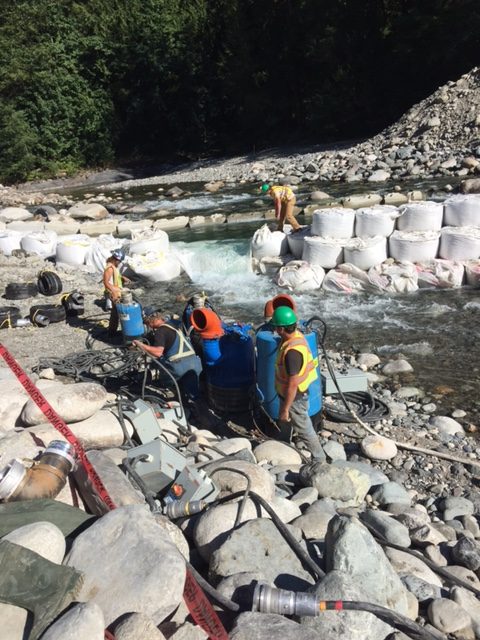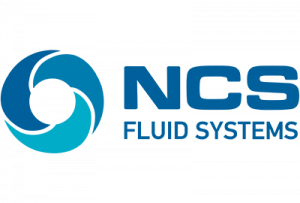
Description Temporary diversion methods are used to reroute water from a stream or restrict flows to a designated portion of the stream channel to allow for construction activities to take place in the stream, along the banks or beneath the active channel. Temporary diversion methods are often required during the construction of detention ponds, dams, in-stream grade control structures, utility installation and other activities, including maintenance, that require working in waterways. Temporary diversion methods include temporary diversion channels, pump-arounds, piped diversions, coffer dams and other similar practices. The primary purpose of all temporary diversion methods is to protect water quality by passing upstream flows around the active construction zone.
Description Temporary diversion methods are used to reroute water from a stream or restrict flows to a designated portion of the stream channel to allow for construction activities to take place in the stream, along the banks or beneath the active channel. Temporary diversion methods are often required during the construction of detention ponds, dams, in-stream grade control structures, utility installation and other activities, including maintenance, that require working in waterways. Temporary diversion methods include temporary diversion channels, pump-arounds, piped diversions, coffer dams and other similar practices. The primary purpose of all temporary diversion methods is to protect water quality by passing upstream flows around the active construction zone. Appropriate Uses Temporary diversion methods are appropriate in situations when it is necessary to divert the flow around the area where work is being conducted. Temporary diversion methods vary with the size of the waterway that is being diverted. For large streams, a temporary diversion may consist of berms or coffer dams constructed within the stream to confine flow to one side of the stream while work progresses on the “dry” side of the berm. For smaller streams and often for construction of dams and detention basins, a temporary diversion method may divert the entire waterway. For short duration projects (typically less than a month of active construction) with low baseflows, a pump and/or bypass pipe may serve as a temporary diversion. Whenever a temporary diversion is used, construction should be scheduled during drier times of the year (November through March) to the extent feasible, and construction in the waterway should progress as quickly as practical to reduce the risk of exceeding the temporary diversion capacity. Timing and duration of construction are primary considerations for determining the design flow most appropriate for a diversion. A sizing method that does not consider these variables is overly simplistic and can result in inflated project costs and land disturbances that provide little to no water quality benefit. Additionally, disturbing more area than necessary can result in increased erosion. Temporary diversion method section and approach should occur on a project- and site-specific basis. For short duration projects (typically associated with maintenance of utilities and stream crossings and minor repairs to outfalls and eroded banks) constructed during dry times of the year, diversion construction can create greater disturbance and mobilization of sediment than all of the other earth disturbing activities of the project combined, and the cost of the diversion could be a significant percentage of the overall project cost. If it can be reasonably determined, based on area and duration of disturbance, that channel work will result in less disturbance and movement of sediment than would occur through installation of a temporary diversion, it is reasonable to exempt these activities from the requirement to construct a temporary diversion.

Design considerations selection and design of temporary diversion methods should consider many factors, including:
- Will construction of a temporary diversion cause greater environmental impacts than if the project is constructed without a temporary diversion? This frequently applies to short duration, small scale projects associated with maintenance activities such as bank erosion repair, drop structure and pond maintenance, outfall improvements/repair and other limited construction activities.
- Size of stream, tributary watershed area and anticipated flow rates during construction. Special consideration should be given to large streams with large tributary areas with higher flow rates since the sizing methodology presented in this Fact Sheet is based on data from watersheds less than 20 square miles.
- Any special water quality or aquatic life conditions the waterway.
- Nature of surrounding land use, property ownership, and easements in the project area are important considerations in determining feasibility and methods for temporary diversions. For example, in a highly urbanized setting or an area with limited right-of-way, there may not be adequate space to construct a diversion channel.
- Seasonal variations in stream hydrology (baseflow vs. peak flow).
- Irrigation flows: If an irrigation ditch enters the stream, it is recommended that the ditch company be contacted to confirm when flows from the ditch may be expected.
- Weather (storm runoff): If diversions are constructed in summer months when thunderstorms and flash flooding can occur, contractors will need to track weather forecasts closely and provide additional protection when higher flows from runoff are anticipated. The UDFCD Alert System can be used for daily forecasts and to provide warnings for severe weather.
- Probability of flood flows exceeding diversion capacity and/or diversion failure. Consider the consequences of exceedance or failure such as:
- Public safety
- Environmental
- Legal
- Regulatory
- Economic
- Project disruption/delay
- Realistic estimation of project duration and time of year during which construction will occur.
| Owen Gilbert, MBA President and CEO 780-910-7951 ogilbert@ncsmanagement.ca |
Kamal Singh PE, Peng. MBA VP Engineering 604 720 0190 ksingh@ncsfluidsystems.ca |
|---|
Share This:





 CDN NEWS |
CDN NEWS |  US NEWS
US NEWS 

































COMMENTARY: Workers Must Be Part of the Energy Transition – Resource Works